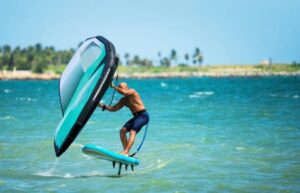Wing foiling is one of the most irresistible new water sports around. It’s easy to learn, the gear packs down small, and it offers a fun and rewarding workout.
Before you start getting ready to fly, it’s essential to prep your stance. That means practising bearing away from your upwind riding position.
What is wing foiling?
 Wing foiling is a new water sport gaining momentum and offering a new irresistible thrill. It’s wind-propelled and combines the disciplines of windsurfing, kitesurfing, and surfing. A sailor stands on a compact board and holds directly onto a hydrofoil that generates lift and propels the board across the water.
Wing foiling is a new water sport gaining momentum and offering a new irresistible thrill. It’s wind-propelled and combines the disciplines of windsurfing, kitesurfing, and surfing. A sailor stands on a compact board and holds directly onto a hydrofoil that generates lift and propels the board across the water.
A complete foil setup comprises a mast, fuselage (that connects the mast to the front wing and stabiliser) and branches; they vary in size depending on rider weight and conditions. For beginners, look for a foil slightly more significant than your body weight to allow you to harness more wind power.
A special wing foiling board is also required to maximise stability and efficiency. These boards are short and wide – cramming a lot of foam into a small surface area – and have foot strap inserts to secure the foil. They’re designed to maximise stability and a low swing weight so you can accelerate more efficiently, even in rough, windy conditions.
What equipment do I need to get started?
Wing foiling is a new sport that infects water sports enthusiasts with its irresistible charm. It requires less equipment than surfing or sailing and offers a fantastic workout. In addition, it’s easy to learn, and the gear packs up into a compact package.
To get started, you’ll need a foil and aboard. Beginner wing foilers should choose a more giant, more stable board that provides enough float to allow you to focus on flying the wing. The best boards for beginners tend to be around 145 litres. For quality wing foiling, click here.
Foils can be bought new or used, and choosing the right one will depend on your goals, weight, and local wind conditions. Whether or not you opt for a boom or soft handles will also be an important consideration – the choice depends on your comfort level and will make a difference to the speed at which you can learn to ride. Some wing foilers prefer the familiar feel of a boom, while others prefer softer handles, which are easier on hands.
How do I find an excellent wing-foiling instructor?
Whether you’re already a water sports star with loads of experience or a complete newbie, the best way to learn to wing foil is with an instructor. Wing foiling instruction usually starts on land to help you understand how the branch works and how to power it up and down. Once you’re comfortable, you can focus on foiling itself, which can feel like balancing a bucking bronco at first!
The beauty of hydrofoils is that they’re highly efficient at creating lift, so you can get going quickly, even in unbroken waves. However, the power required to drive them is enormous, so you must find an instructor with an excellent safety record and a solid understanding of all aspects of this fantastic sport! For quality wing foiling, click here.
For beginners, it’s ideal to get some time towing behind a jet ski or on an e-foil board to get the hang of the balance of a rising foil.
Where can I learn to wing foil?
As a beginner, you will want to learn in calm water. A lake is ideal as it offers safety away from waves. However, the sport can be done in the ocean, too. You just need to find a spot protected from large breaking waves or pick a swell-free day. A hydrofoil creates lift and gets you moving even with very little wind. Wing foil boards are short, wide, and very thick to cram lots of stability into a small surface area.
Once you master the basics, try a downwinder. Some of the best spots for wing foiling are Jupiter (with its outer sandbar), St. Petersburg and Tampa.
Wing Foiling Gear Recommendations
Wing foiling is a relatively new sport that requires an intimate understanding of wind and water. It’s best to start in calm, flat water away from waves.
The right gear is crucial for a successful session. Check out the recommended equipment below and some tips to get started!